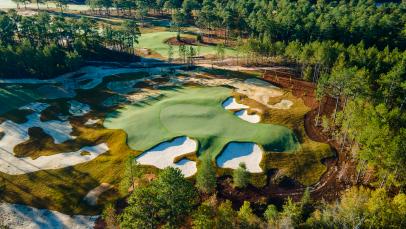'Every Hole At'
Our Pinehurst No. 2 drone tour reveals the subtle brilliance of this iconic U.S. Open course

Let’s be frank: the merits of Pinehurst No. 2 can fly right past most golfers. Everyone who visits the resort wants to play the fabled No. 2, ranked 29th on America’s 100 Greatest Courses, but many who do leave thinking either it’s too brutally difficult, or they don’t get the fuss.
There are no long-range vistas, no bunkers that look chiseled from marble and no breathtaking water holes. The design’s brilliance resides not in the spectacular but in the subtle and the degrees that small distances—feet, inches—can result in vastly diverse shot outcomes. Getting on the wrong side of a slope or contour can mean the difference between a par and double bogey. Pinehurst No. 2 is the sum of a thousand small parts that look the same but function differently to create a machine that slowly grinds away scores, one fractional stroke at a time.
Though the Pinehurst No. 2 that we know today dates to 1935, the year all the final pieces were put into place including architect Donald Ross’ conversion of the old flat sand greens to voluptuously contoured Bermuda grass putting surfaces, it didn’t host a U.S. Open until 1999. But since then it’s become a mainstay in the USGA rota—and is now an anchor site that hosts its fourth Open this June and will do so again in 2029, 2035, 2041 and 2047.
Famous for its crowned greens, No. 2 presents an extreme challenge to anyone trying to shoot 68 because the line between a good shot and a disaster is as fine as it gets in major championship golf outside of Augusta National. To make birdies, players must take on difficult hole locations with unerring control and precision, one green after another. But the beauty of the course is that, with little alteration to the setup, it can play relatively easy for resort guests if they can competently drive the ball into the generous fairways and use their putters around the greens. For them the rule is simple: Keep the ball on the ground, and play to the middle of the greens.
Watch our “Every Hole at Pinehurst No. 2” video for more about the mysteries and subtle majesty of this American golf icon.
Watch our exclusive drone tour
• • •
Explore Golf Digest's new Course Reviews section where you can submit a star rating and evaluation on all the courses you’ve played. We've collected tens of thousands of reviews from our course-ranking panelists to deliver a premium experience, which includes course rankings, experts' opinions, bonus course photography, videos and much more. Check it out here!

